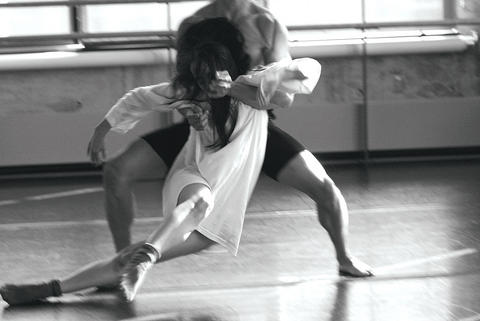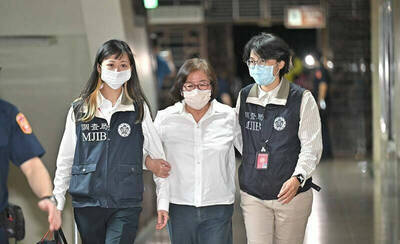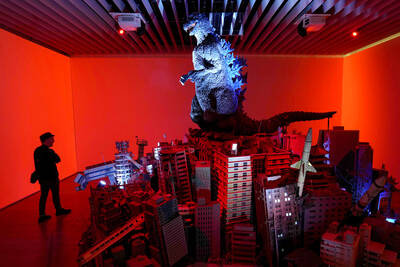Watching Sheu Fang-yi (許芳宜) is like watching a force of nature. Onstage she is a mass of contradictions: fierce, tender, ephemeral, steadfast, poetic, earthy, fragile, incredibly strong, small but able to make her legs look extra long.
Watching Sheu was what LAFA's (拉芳) 37 Arts production was all about, with choreography that catered to her strengths and charisma. But while it was Sheu who drew the audiences that packed all four performances of LAFA's inaugural season at Novel Hall from Jan. 17 to Jan. 19, the company that she and long-time partner Bulareyaung Pagarlava (Bula, 布拉瑞揚) have formed more than delivered on their promise of a new force in Taiwan's dance world.
Choreographer Sang Ji-jyia's (桑吉加) 10-minute The Duet, set to music by Ryoji Iked, quietly set the pace for the evening. His spare, stripped-down moves made the most of Sheu and partner Chou Shu-yi's (周書毅, of MDans) easy articulation. Chou is always enjoyable to watch and he more than held his own with Sheu.

PHOTO COURTESY OF LAFA
The second piece was a study in black and white, a solo for Sheu from Bula's 2002 The Single Room. Clad in a sheer black negligee-like shift, Sheu approaches her partner, a long table that sits center stage. She dances around it, against it, with it, on it and under it, back-lit for the most part so that it is her silhouette that you are watching, a graceful shadow against an immovable object.
At times the table acts as a ballet bar; other times it is more substantial, as she half lays upon it. She appears incredibly fragile, but that fragility is belied by the strength needed to maintain her balance.
The solo is one of Bula's most balletic pieces and it was a complete contrast to the final work on the program, 37 Arts, a one-two punch that demonstrated his growth as a choreographer.
Once again the table takes center stage as 37 Arts opens, only this time there are three chairs around it. Two young men, clad in huge oversized white T-shirts, take their seats, followed by a similarly clad Sheu. What follows is a rollicking Keystone Cops silent movie battle for a white bottle, first done fast, then repeated in slow motion as if lit by a strobe, all set to a cancan score. Eyes bulge, hair gets pulled, the audience gets the giggles.
Then Huang Ming-cheng (黃明正) enters, clad only in black bathing trunks, and performs a series of acrobatic feats that leaves the audience both cheering and eating out of his hand: handstands, hoop jumps and rope tricks, is there nothing this man can't do?
The slap-stick pace is maintained through the next sequence, set to I love Paris. But before you know it the pace and the mood have shifted. The friendly acrobat has become a menacing figure in a dark duet with Sheu as he grabs her hair, her T-shirt, picks her up and tosses her about.
Huang spins Sheu around much like an adult would play airplane with a child, her body parallel to the ground. But since he is holding only cloth, you find yourself hoping that the material will hold through another performance. They swirl like ice skaters, but there's a sickening edge to the movements. In the end, Sheu, her hair hanging down over her face, twitches and moves like a broken doll. No one is laughing now, the audience sits in dead silence.
Then the curtain is raised, the table is back, and all four dancers come out with their costumes turned into modified clown outfits for a cancan reprise and smiles all around. It was a powerful performance, and a reminder how good Bula is at evoking strong emotions both onstage and among the audience.

Following the shock complete failure of all the recall votes against Chinese Nationalist Party (KMT) lawmakers on July 26, pan-blue supporters and the Chinese Communist Party (CCP) were giddy with victory. A notable exception was KMT Chairman Eric Chu (朱立倫), who knew better. At a press conference on July 29, he bowed deeply in gratitude to the voters and said the recalls were “not about which party won or lost, but were a great victory for the Taiwanese voters.” The entire recall process was a disaster for both the KMT and the Democratic Progressive Party (DPP). The only bright spot for

As last month dawned, the Democratic Progressive Party (DPP) was in a good position. The recall campaigns had strong momentum, polling showed many Chinese Nationalist Party (KMT) lawmakers at risk of recall and even the KMT was bracing for losing seats while facing a tsunami of voter fraud investigations. Polling pointed to some of the recalls being a lock for victory. Though in most districts the majority was against recalling their lawmaker, among voters “definitely” planning to vote, there were double-digit margins in favor of recall in at least five districts, with three districts near or above 20 percent in

From Godzilla’s fiery atomic breath to post-apocalyptic anime and harrowing depictions of radiation sickness, the influence of the nuclear bombings of Hiroshima and Nagasaki runs deep in Japanese popular culture. In the 80 years since the World War II attacks, stories of destruction and mutation have been fused with fears around natural disasters and, more recently, the Fukushima crisis. Classic manga and anime series Astro Boy is called “Mighty Atom” in Japanese, while city-leveling explosions loom large in other titles such as Akira, Neon Genesis Evangelion and Attack on Titan. “Living through tremendous pain” and overcoming trauma is a recurrent theme in Japan’s

The great number of islands that make up the Penghu archipelago make it a fascinating place to come back and explore again and again. On your next trip to Penghu, why not get off the beaten path and explore a lesser-traveled outlying island? Jibei Island (吉貝嶼) in Baisha Township (白沙鄉) is a popular destination for its long white sand beach and water activities. However, three other permanently inhabited islands in the township put a unique spin on the traditional Penghu charm, making them great destinations for the curious tourist: Yuanbeiyu (員貝嶼), Niaoyu (鳥嶼) and Dacangyu (大倉嶼). YUANBEIYU Citou Wharf (岐頭碼頭) connects the mainland